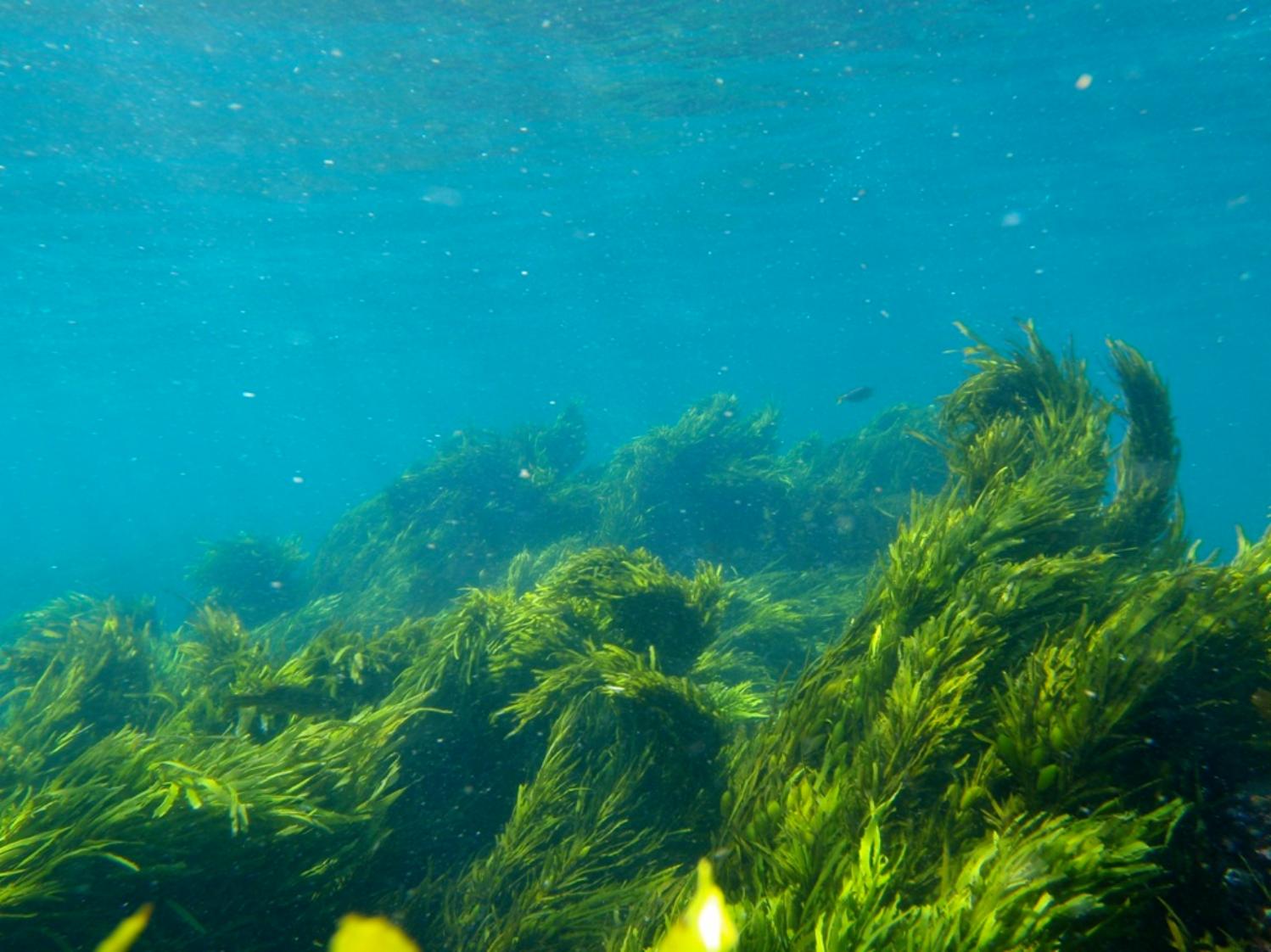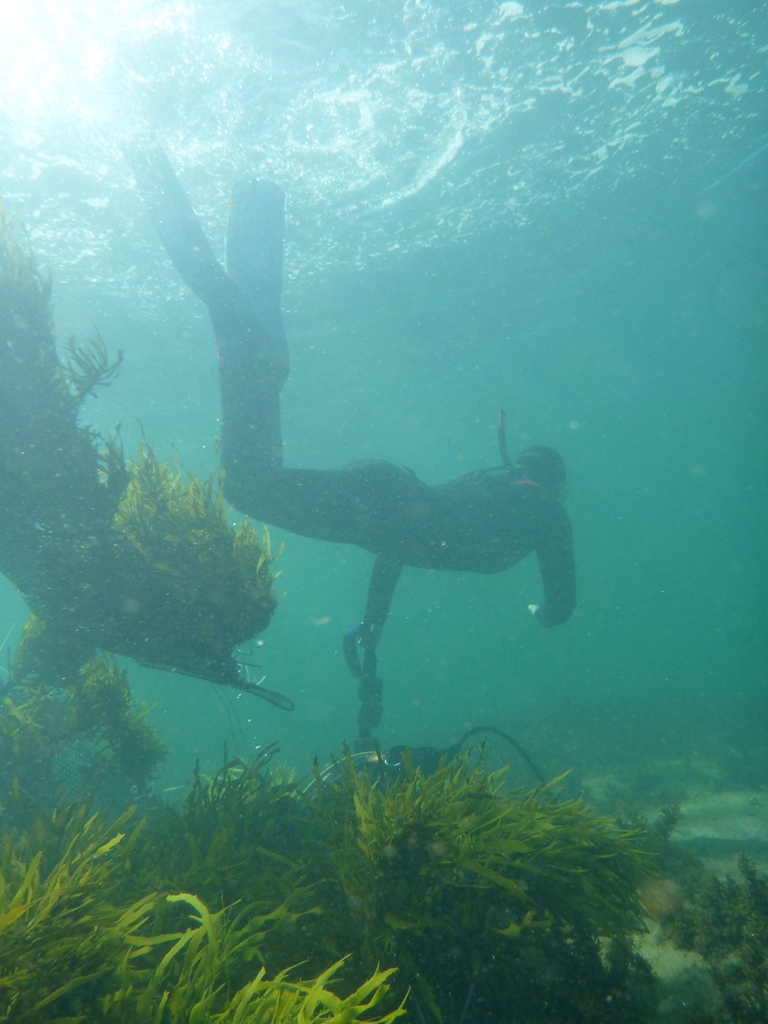January 19 - 25, 2014: Issue 146
Palm Beach Seaweed Contributes to Reef Restoration - Bald Reef Gets New Growth With Seaweed Transplant

Palm Beach Seaweed Contributes to Reef Restoration - Bald Reef Gets New Growth With Seaweed Transplant
January 14, 2014: by UNSW
Marine ecologists in Sydney have successfully restored a once thriving seaweed species, which vanished along a stretch of the city's coastline during the 1970s and 80s when there were high levels of sewage.
A team of researchers from UNSW, the Sydney Institute of Marine Science and the NSW Department of Primary Industries has transplanted fertile specimens of the missing crayweed (Phyllospora comosa) onto two barren reef sites where it once grew abundantly.
They took seaweed from Palm Beach and Cronulla and transplanted it to Long Bay and Cape Banks. Their results are reported in the journal PLOS ONE.
 "Seaweeds are the 'trees' of the oceans, providing habitat structure, food and shelter for other marine organisms, such as crayfish and abalone," says lead author, Dr Alexandra Campbell, from the UNSW Centre for Marine Bio-Innovation.
"Seaweeds are the 'trees' of the oceans, providing habitat structure, food and shelter for other marine organisms, such as crayfish and abalone," says lead author, Dr Alexandra Campbell, from the UNSW Centre for Marine Bio-Innovation.
"The transplanted crayweed not only survived similarly to those in natural populations, but they also successfully reproduced. This creates the potential for a self-sustaining population at a place where this species has been missing for decades," she says.
Right: Transplanted seaweed is attached to a reef by a team member
Large brown seaweeds - known as macroalgae - along temperate coastlines, like those in NSW, also encourage biodiversity and are important to the region's fishing and tourism industries.
However, these seaweed ecosystems face increasing threats of degradation due to human impacts and ocean warming. The authors say the potential environmental and economic implications of losing these habitats would be comparable to the more highly publicised loss of Australia's tropical coral reefs.
In 2008, researchers from UNSW and the NSW Department of Primary Industries (DPI) showed that a 70 km stretch of this important habitat-forming crayweed had vanished from the Sydney coast decades earlier, coinciding with a period known for high levels of sewage.
Despite improved water quality around Sydney after the introduction of better infrastructure in the 1990s, which pumped sewage into the deeper ocean, the 70 km gap of depleted 'underwater forest' - between Palm Beach and Cronulla - has never been able to recover naturally.
Now, with some well-executed intervention, it looks as though this habitat-forming crayweed could make a successful comeback in Sydney's coastal waters.
"This is an environmental good news story," says research supervisor UNSW Professor Peter Steinberg, Director of the Sydney Institute of Marine Science.
"This kind of restoration study has rarely been done in these seaweed-dominated habitats, but our results suggest that we may be able to assist in the recovery of underwater forests on Sydney's reefs, potentially enhancing biodiversity and recreational fishing opportunities along our coastline."
The researchers say their results could provide valuable insights for restoring similar macroalgae marine ecosystems in Australia and globally, but further research is needed to understand the complex processes that affect recruitment and survival.
This project was funded in part by a grant from the NSW Recreational Fishing Trust.
Alexandra H. Campbell, Ezequiel M. Marzinelli, Adriana Vergés, Melinda A. Coleman, Peter D. Steinberg. Towards Restoration of Missing Underwater Forests. PLoS ONE, 2014; 9 (1): e84106 DOI: 10.1371/journal.pone.0084106 - Open Access ONLINE
School of Biological, Earth and Environmental Sciences – UNSW
The University of New South Wales has a national and international reputation for quality education and research in many fields of biological, geographical and geological sciences.
The School of Biological, Earth and Environmental Sciences (BEES) incorporates these environmentally relevant disciplines enabling the School to offer a comprehensive education in the traditional, mainstream disciplines of Biology, Geography and Geology. This also allows us to provide our students with opportunities for interdisciplinary and multidisciplinary studies, notably in the Marine and Environmental Sciences.
Our Bachelor of Science (BSc) degree programs are available to qualified students and cater for a wide array of interests and career paths. An additional 4th Year Honours Program is available to all students who have performed well in earlier years, including students from universities other than UNSW.
There is almost no limit to the area of research in Master (MSc) and Doctor of Philosophy (PhD) programs.
See more at: www.bees.unsw.edu.au/
Sydney Institute of Marine Science - www.sims.org.au/
The Sydney Institute of Marine Science (SIMS) conducts multidisciplinary marine research across five core research themes - Urbanisation, Biodiversity, Climate Change, Ocean Resources, and Marine Management. SIMS is also the operator of the NSW node of the Australian Government’s Integrated Marine Observing System – IMOS.
SIMS plays a vital role in producing the next generation of marine researchers and managers by facilitating the research of PhD students and post doctoral fellows, and through undergraduate and postgraduate teaching at the Institute. Post graduate opportunities offered include the SIMS Master of Marine Science and Management and SIMS Doctoral Fellowships which are awarded annually.
SIMS educational responsibilities go beyond training scientists, and beyond research outcomes. We want to be science interpreters, articulating our research programs, and exciting the community about the marine world through a variety of outreach opportunities including citizen science programs . We aim to promote responsibility at an individual and community level for the protection and conservation of our marine riches.
NSW Recreational Fishing Trust
All money raised by the NSW Recreational Fishing Fee is placed into the Recreational Fishing Trusts and spent on improving recreational fishing in NSW. These trusts are regulated by law and overseen by two committees made up of recreational fishers - one for saltwater and one for freshwater.
Anyone can apply for funding from the Recreational Fishing Trusts, including fishing clubs and organisations, universities, councils, community groups, individuals and so on.
A wide variety of programs are being funded by the Recreational Fishing Trusts:
Recreational fishing enhancement programs; Recreational fishing education; Fishing access and facilities; Aquatic habitat protection and rehabilitation; Enforcement of fishing rules; Research on fish and recreational fishing; Fishing fee coordination and payment network
Each year the Trusts also fund a large number of small grants.
Anyone can apply for funding from the Recreational Fishing Trusts, including fishing clubs and organisations, universities, councils, community groups, individuals and so on. Joint applications are also encouraged. Funding applications must relate to the improvement of recreational fishing.
Priorities for funding from the Trusts Funds include: recreational fisheries enhancement; angler education and information; research on recreational fishing; recreational fisheries access and facilities; and recreational fisheries sustainability.
Please note, funding from the Recreational Fishing Trusts for projects that restore, rehabilitate and protect fish habitat in NSW is available through the Habitat Action Program. These Habitat Action Grants are available in August each year and require a separate habitat-specific Funding Application form, which is different to the forms available here. For further information on the Habitat Action Grants please contact the Habitat Action Program coordinator on fish.habitat@dpi.nsw.gov.au or phone (02) 6881 1277.
See forms and related information at: www.dpi.nsw.gov.au/fisheries/recreational/licence-fee/apply-for-funds
_____________________________________________________
Dr Alexandra Campbell, B. Sc. (Hons 1), PhD, UNSW - Postdoctoral Research Associate
Research Interests
My research focuses on interactions between habitat-forming organisms in marine ecosystems and the things that eat, grow on or infect them. I’m particularly interested in how changing environmental conditions alter these interactions and what ecological and biological consequences such alterations have at individual, community and ecosystem scales. A recent focus of my research has been climate-mediated diseases, which are increasing with frequency and severity in diverse habitats globally. Although I’m interested in marine habitat formers generally (including corals and seagrasses), most of my research to date has involved seaweeds. These marine macrophytes form underwater forests and are the basis of coastal, temperate marine ecosystems, supporting other organisms from the ‘bottom-up’ by providing food and shelter. Seaweeds are showing evidence of global decline and this could have potential far-reaching ecological and socio-economic implications. Through my research, I aim to address this problem by trying to both understand and describe the mechanistic causes of declines and develop solutions for their prevention and amelioration.
See more here
Professor Peter Steinberg - Co-Director, Advanced Environmental Biotechnology Centre (AEBC), Director and CEO, Sydney Institute of Marine Sciences (SIMS), Co-Director, Centre for Marine Bio-Innovation
Research Interests
Climate change and diseases of marine organisms
In the last ten years the effects of disease on natural marine communities have become increasingly apparent, with organisms as diverse as seagrasses, seals and corals suffering from major disease-related die-offs. In a number of these instances human impacts via pollution or climate change are thought to have played a major role in the impact of these diseases. Recent evidence indicates that "bleaching" of the red seaweed Delisea pulchra is due to a bacterial disease. We are now investigating broadly the interplay between bacterial virulence and environmental factors such as temperature, light and nutrients, and natural bacterial inhibitors to understand the epidemiology and impact of disease on the ecology of kelps and other seaweeds.
Marine Chemical Ecology
The identification of novel bioactive compounds is an emergent field that represents a unification of the fields of molecular biology, microbiology, natural products chemistry, and marine ecology. The field of marine chemical ecology has long been dominated by studies of plant/herbivore or predator/prey interactions and our group has a long history of investigating these interactions at all levels, form the molecular to the biogeographical. Increasingly our work in this area also encompasses studies of settlement inducers for invertebrate larvae. Chemical inducers of settlement act as cues for settling propagules (larvae, spores, etc.), enabling these planktonic forms to settle in an appropriate habitat for resumption of the benthic (bottom-dwelling) phase of their life history. The analysis of cues which control settlement in marine organisms and understanding the generality or specificity at which these cues operate is fundamental to advancing our understanding of adult distribution and abundance, population and community variability and hence our ability to manage natural marine systems.
Synergies between marine ecology and environmental microbiology
Marine organisms are subject to a constant bombardment from millions of microbial cells typically found in every millilitre of seawater. Interactions between marine macro- and micro-organisms are important in structuring marine communities and have been linked to the evolution of chemical defences, the maintenance of genetic diversity and even the evolution and persistence of sex. Understanding marine prokaryote/ eukaryote interactions has implications for a remarkably diverse array of endeavours, from the preservation of marine biodiversity to an understanding of diseases of marine and aquatic organisms to the development of novel antibiotics. These studies overlap broadly across our entire research program.
Biofilms
Marine microorganisms predominantly exist in sessile communities rather than as free-living planktonic cells. These sessile communities develop on all surfaces in aqueous environments, as complex surface attached micro-colonies. Such differentiated surface communities, in which bacterial cells are embedded in a macromolecular containing matrix, are called biofilms. Biofilms form on marine eukaryotes ('living surfaces') and here space and nutrient limitations create a highly competitive environment. This has allowed surface microbes to evolve both defensive and antagonistic strategies, including the production of toxins and other biologically active secondary metabolites to evade predators and/or prevent the colonisation and growth of competitors.
See more here

Report and Images Courtesy University of NSW, 2014.